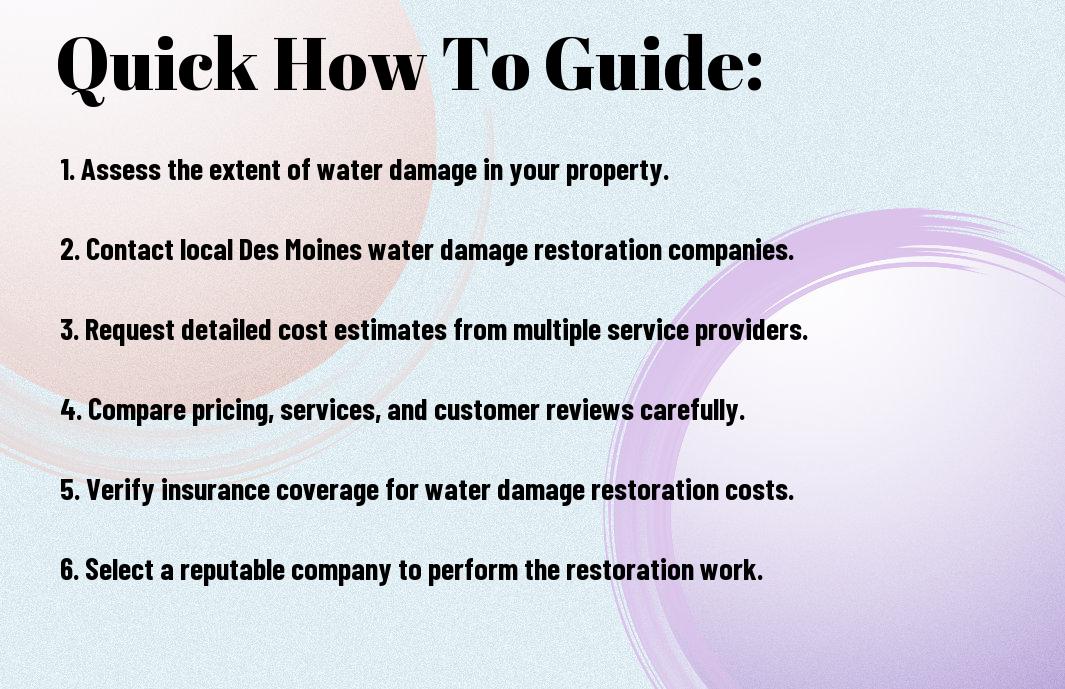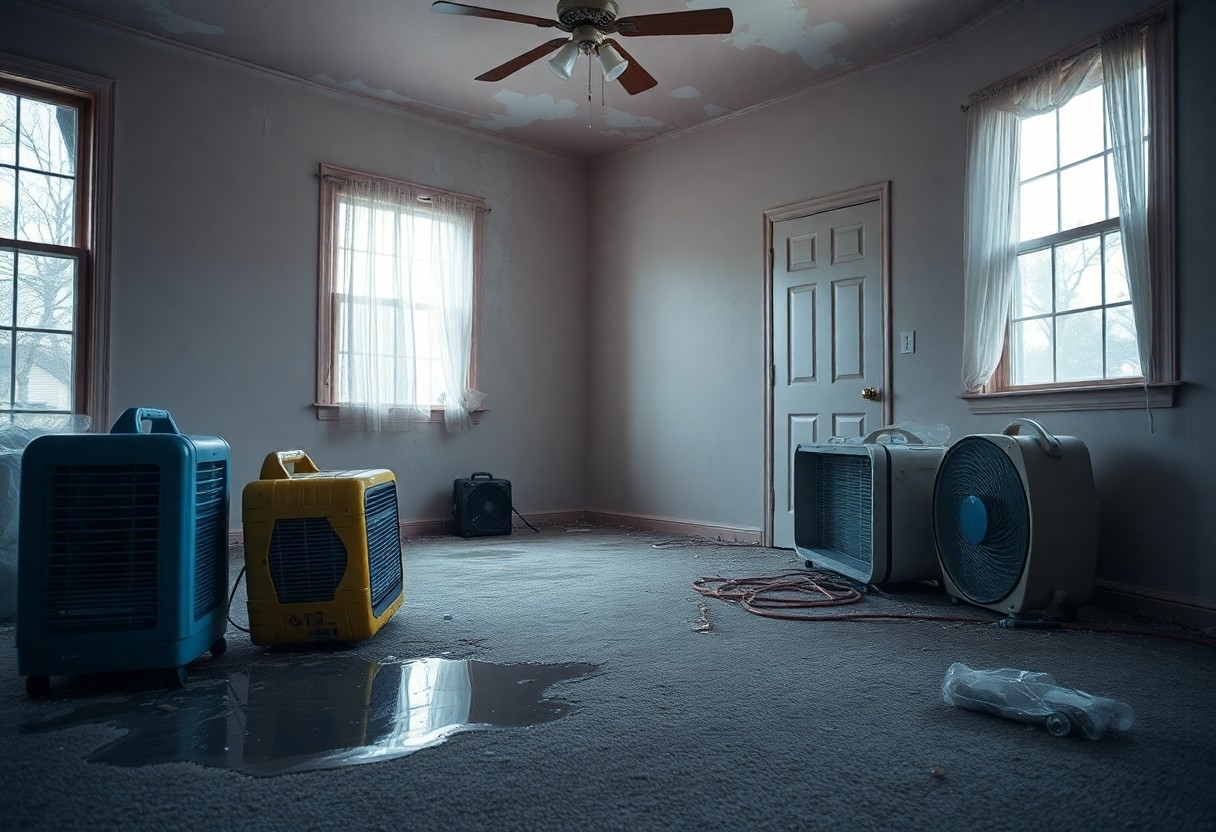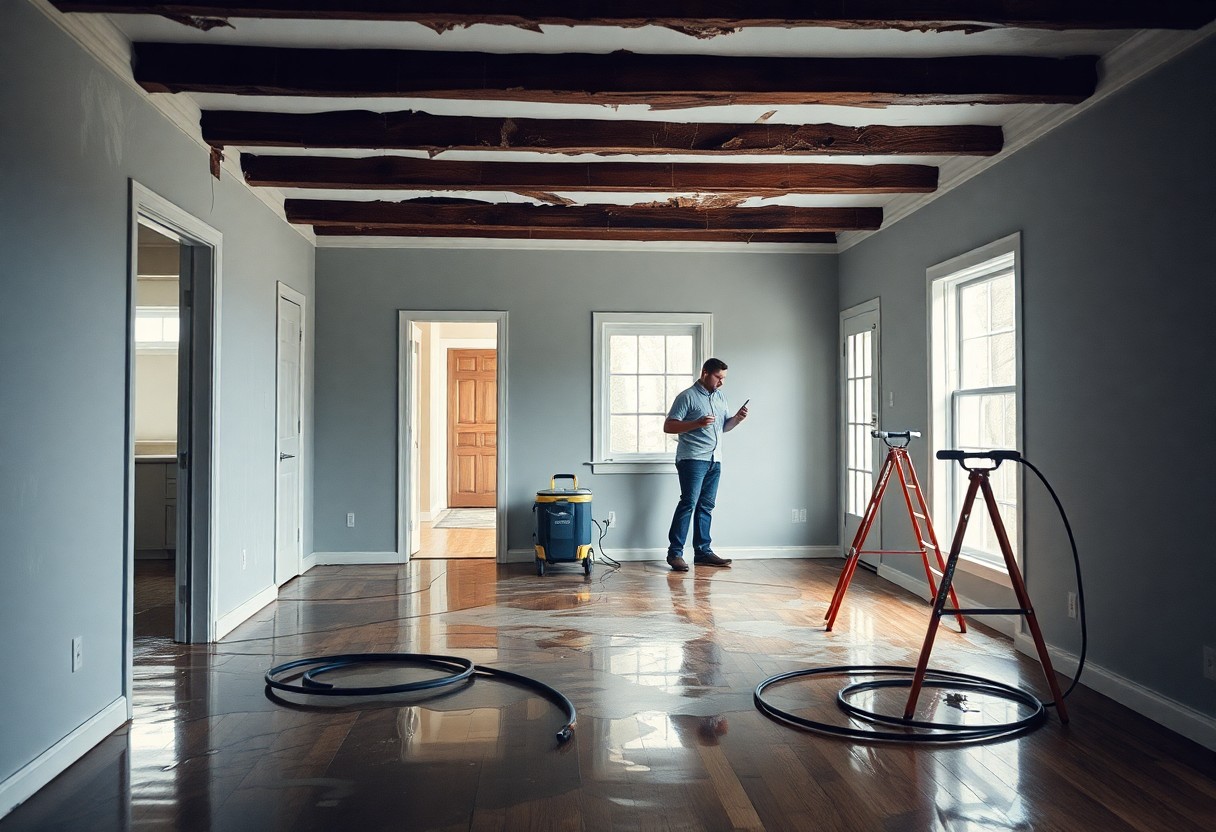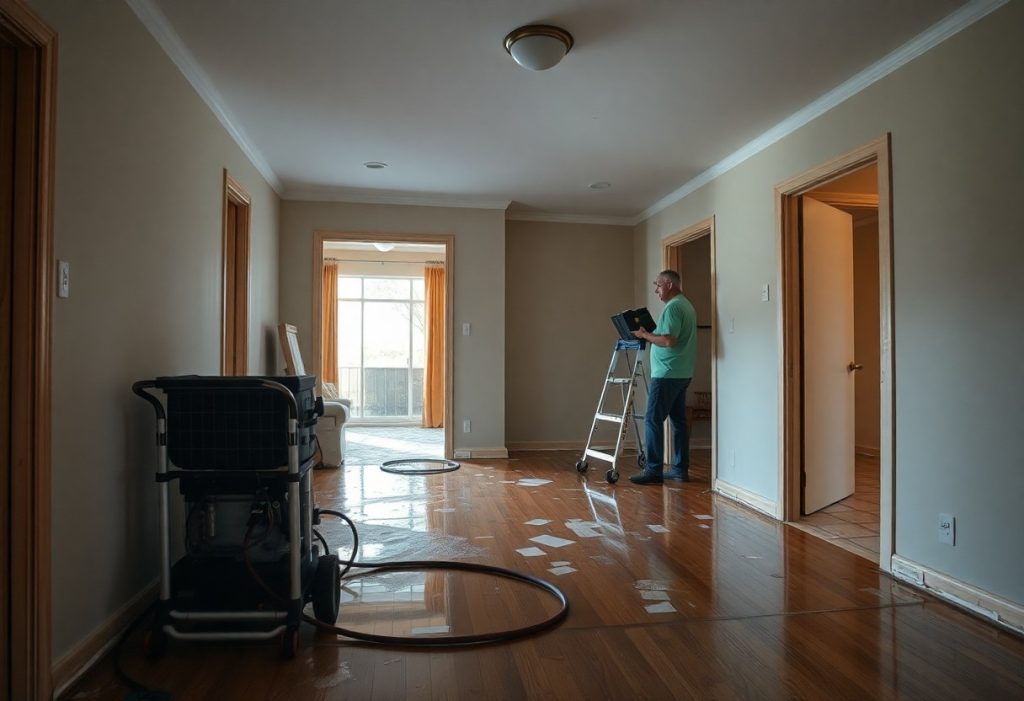Understanding Water Damage Restoration Pricing in Des Moines
Your expenses for water damage restoration in Des Moines will vary based on multiple factors, including the extent of damage and the services required. Typically, homeowners might spend anywhere from $1,000 to $5,000, depending on the severity of the issue. For minor issues like small leaks, costs often remain on the lower end. However, comprehensive restorations involving extensive structural damage or mold removal can easily climb higher. For example, if you experience a burst pipe that floods your basement, the cost of extraction, drying, and repairs could reach upwards of $10,000. Engage with local contractors to obtain accurate quotes tailored to your specific situation, ensuring you’re fully informed of the necessary investments to restore your home properly.
The Factors That Drive Restoration Costs
Understanding the costs associated with water damage restoration is fundamental for homeowners. Several factors are at play that can significantly influence the final bill. The variance in pricing may depend on various elements, including the severity of damage, type of water involved, the area affected, and additional services required. Each piece contributes to the overall process and financial obligation. Here’s a brief overview of what drives those costs:
- Severity of water damage
- Type of water (clean, gray, or black)
- Size and structure of the affected area
- Extent of restoration services required
Perceiving these elements can better prepare you should you face water damage in your home.
Severity of Damage: Analyzing the Impact
Damage severity plays a pivotal role in determining the restoration cost. Minor leaks may just need simple fixes and minor drying, while extensive flood damage could necessitate full-scale repairs and replacement of materials. Assessing the extent of the damage promptly helps in estimating costs accurately and can influence the speed at which recovery takes place.
Type of Water Involved: Clean, Gray, or Black
The type of water involved in the damage is another determinant of restoration costs. Clean water, such as from a burst pipe, is less hazardous and demands fewer resources to mitigate compared to gray water from sinks or black water from sewage, posing serious health risks. Each type requires different cleaning and restoration protocols that inherently affect pricing.
For instance, clean water might only require basic extraction and drying, making it relatively inexpensive. However, gray water may necessitate the use of specialized equipment for treatment and purification, increasing the overall cost. Black water, on the other hand, involves hazardous contamination and often requires a complete sanitization, significantly raising expenses due to safety protocols and material replacement.
Area Affected: Room Size and Structure
The size and structure of the affected area also contribute to the restoration cost. Smaller rooms may incur lower costs simply because there’s less material to replace and less labor required for restoration. Conversely, extensive flooding in larger areas such as basements or open living spaces generally leads to higher overall bills, especially when accounting for material replacement like flooring and drywall.
For example, water damage in a small bathroom might involve drying out flooring and walls swiftly, whereas a complete overhaul of a finished basement could require extensive demolition, reconstruction, and possibly even structural repair due to saturated walls and flooring. Understanding the implications of the area impacted is vital to gauging what your financial responsibilities may be in the event of water damage.

Hidden Costs in Restoration Services
Apart from the visible expenses associated with water damage restoration, hidden costs can significantly impact your budget. Factors such as potential mold growth, structural repairs, and the need for specialized equipment often come into play. Unexpected issues can arise once the restoration process begins, making it vital to be prepared for unforeseen expenses. Conducting a thorough assessment prior to starting work can help uncover some hidden costs, allowing you to budget more effectively.
Insurance Implications and Coverage Insights
Understanding your insurance policy can be a game changer when it comes to covering water damage restoration costs. Many homeowners’ insurance policies may include coverage for certain types of water damage, such as those from sudden leaks or burst pipes. However, damage stemming from neglect or lack of maintenance may not be covered. Always review your policy and consult with your agent to clarify coverage limits and deductible requirements.
Equipment and Labor Charges: What to Expect
Expect equipment and labor charges to comprise a significant portion of your restoration costs. Basic services may include water extraction, drying, and dehumidification, which typically utilize specialized machines like industrial grade dehumidifiers and air movers. Labor costs vary based on the complexity of the job, the size of your property, and the required expertise. On average, restoration professionals charge between $50 to $150 per hour, depending on their level of experience and the region.
Moreover, the type and extent of equipment required can lead to varying costs. For example, a standard home may only need air movers and dehumidifiers, while a larger structure might require heavy-duty extraction units and monitoring equipment. Additional tools for mold remediation, insulation removal, or structural drying may also increase your total charges. Some companies even offer package deals that bundle equipment and labor, which could save you money overall while ensuring you get comprehensive service to tackle all aspects of the restoration. Always request a detailed estimate before committing to any work to avoid surprises down the line.
Choosing the Right Restoration Company
Selecting the appropriate restoration company ensures your water damage issues are resolved effectively and professionally. It’s wise to seek a company that has excellent reviews, proper certifications, and offers comprehensive services. ServiceMaster by Rice provides exceptional Water Damage Restoration Services | Des Moines, IA, ensuring you receive the highest quality care in your restoration process.
Key Qualities of a Trusted Restoration Expert
Look for restoration experts who demonstrate thorough knowledge of water damage protocols and possess appropriate certifications. Transparency with pricing, responsiveness to your inquiries, and a solid reputation within your community are also imperative factors. Companies that offer 24/7 emergency services can be a significant advantage, ensuring they’re available when you need them most.
Questions to Ask Before Hiring
Before committing to a restoration company, ask them about their experience, response time, and the techniques they use for water damage restoration. Inquire about their insurance and warranty policies, as well as the certifications and training their technicians undergo. These questions reveal their commitment to quality service and customer satisfaction.
When discussing your needs with potential restoration companies, don’t hesitate to request references or examples of previous work. This information helps gauge their reliability and effectiveness in handling similar situations. Additionally, obtaining written estimates from multiple companies allows you to compare costs and services. Ensuring clear communication and a well-defined contract will enhance your overall experience and peace of mind throughout the restoration process.

Maximizing Your Insurance Coverage for Water Damage
Understanding how to make the most of your insurance can significantly reduce your out-of-pocket expenses during water damage restoration. First, familiarize yourself with your policy details, including what types of water damage are covered and any exclusions that may apply. Keeping detailed documentation of the damage and any related expenses also helps streamline the claims process, ensuring you receive fair compensation for your losses.
Navigating Claims: A Step-by-Step Approach
| 1. Assess Initial Damage | Document the extent of water damage and take photos. |
| 2. Contact Your Insurance Company | Report the damage and understand the claims process. |
| 3. File a Claim | Submit required documentation and evidence of damage. |
| 4. Follow Up | Keep in touch with your claims adjuster for updates. |
| 5. Receive Compensation | Once approved, receive a payout for your covered losses. |
Common Denials and How to Avoid Them
Insurance claims can often be denied due to unintentional oversights on your part. Familiarizing yourself with common reasons for denials can help you avoid pitfalls. These include failing to report damage promptly, not documenting losses adequately, or neglecting to follow policy guidelines for repairs and restoration.
Common reasons for claims denials typically revolve around insufficient documentation and timing. For instance, some policies require that you report the damage within a specific timeframe. Ensure you keep a detailed record of all communications related to your claim and maintain thorough documentation—pictures of the damage, receipts of repairs, and any correspondence with your insurance agent can fortify your case. Moreover, requesting a copy of your insurance policy upfront allows you to clarify what is included in coverage, minimizing the likelihood of surprises during the claims process.

Planning for Future Water Damage: Prevention Strategies
Implementing effective prevention strategies can save you from the stress and costs linked to water damage. Assessing your property’s vulnerabilities and ensuring you have robust measures in place will reduce the likelihood of future incidents. From regular maintenance tasks to strategic investments, each step you take can contribute to keeping your home safe and dry.
Seasonal Maintenance to Reduce Risk
Taking proactive steps during each season is key to minimizing your risk of water damage. Regularly clean your gutters to prevent overflow, check your roof for leaks after storms, and inspect your basement for signs of moisture. Additionally, winterizing outdoor faucets can prevent freezing and bursting pipes, ensuring that your home remains protected year-round.
Essential Upgrades and Investments
Investing in vital upgrades can significantly enhance your property’s resilience to water damage. Consider installing sump pumps in basements, waterproofing foundations, and upgrading to high-quality plumbing systems. These enhancements not only protect your home but may also increase its overall value. As an example, a sump pump could cost around $1,000 to install but may save you tens of thousands in damage repairs later on.
Prioritizing these upgrades ensures you are making a strategic investment in your property’s safety. Incorporating features like flood-resistant materials, improved drainage systems, and reinforced windows adds an extra layer of protection. An investment in quality sump pumps can provide peace of mind, especially in areas prone to flooding, and makes a significant difference in emergency situations. By planning and budgeting for these upgrades, you create a formidable defense against the risk of water damage, ultimately safeguarding both your home and finances for years to come.
Summing up
Conclusively, understanding the water damage restoration cost in Des Moines is vital for your financial planning and timely recovery. Factors such as the extent of damage, materials affected, and necessary equipment influence the overall price. By obtaining quotes from local professionals and considering your insurance coverage, you can better navigate these costs and ensure your property is restored effectively. Being informed allows you to make sound decisions that protect your home and finances in the long run.
FAQ
Q: What factors influence the cost of water damage restoration in Des Moines?
A: The cost of water damage restoration in Des Moines can vary significantly based on several factors. These include the extent of the water damage, the type of water involved (clean, gray, or black water), the size of the affected area, and the materials that need to be replaced or repaired. Additionally, the response time post-damage can also affect the cost; the quicker the response, the lower the potential for secondary damage like mold growth. Labor costs in the area and any necessary equipment or specialized services can also contribute to the final price.
Q: Is water damage restoration covered by homeowners insurance in Des Moines?
A: Many homeowners insurance policies include coverage for water damage restoration, but the specifics can vary widely based on the policy and the cause of the water damage. Typically, sudden and accidental damage, such as from a burst pipe, is covered, whereas damage from long-term neglect, such as a slow leak, may not be. It’s necessary to review your policy and consult with your insurance agent to understand your coverage and what documentation may be needed to file a claim.
Q: How can I find affordable water damage restoration services in Des Moines?
A: To find affordable water damage restoration services in Des Moines, start by researching local companies and reading customer reviews. It can be helpful to request quotes from multiple providers to compare costs. Look for services that offer free assessments or consultations, as they can give you an estimate without additional charges. Don’t forget to inquire about any discounts or financing options they may offer. Additionally, consider asking friends or family for recommendations to find a reliable, cost-effective service.

